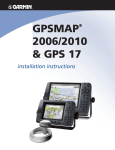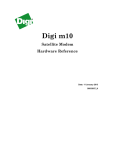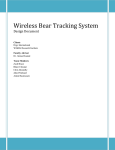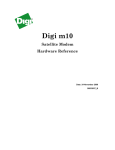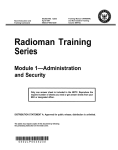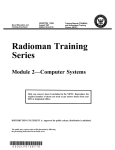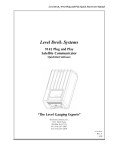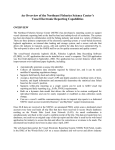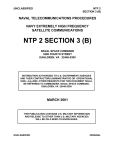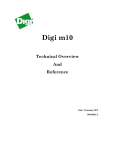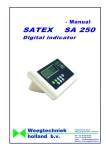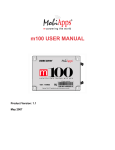Download U.S. Coast Guard Research and Development Center
Transcript
U.S. Coast Guard Research and Development Center 1082 Shennecossett Road, Groton, CT 06340-6096 Report No. ORBCOMM TEST & EVALUATION FINAL REPORT NOVEMBER 1999 Distribution limited to U.S. Coast Guard only. Other requests shall be referred to the U.S. Coast Guard Research and Development Center, Groton, CT 06340-6096. Prepared for: U.S. Dept of Transportation United States Coast Guard Office of Communications Systems (G-SCT) Washington, DC 20593-0001 N O T I C E This document is disseminated under the sponsorship of the Department of Transportation in the interest of information exchange. The United States Government assumes no liability for its contents or use thereof. The United States Government does not endorse products or manufacturers. Trade or manufacturers’ names appear herein solely because they are considered essential to the object of this report. This report does not constitute a standard, specification, or regulation. Marc B. Mandler, Ph.D. Technical Director United States Coast Guard Research & Development Center 1082 Shennecossett Road Groton, CT 06340-6096 ii Technical Report Documentation Page 1. Report No. 4. 2. Government Accession Number Title and Subtitle 3. Recipient’s Catalog No. 5. Report Date November 1999 Orbcomm Test and Evaluation 6. Performing Organization Code Project No. 9250.7 7. Author(s) 8. Performing Organization Report No. RDC-271-99 Amy B. Grable 9. Performing Organization Name and Address 10. Work Unit No. (TRAIS) U.S. Coast Guard Research and Development Center 1082 Shennecossett Road Groton, CT 06340-6096 11. Contract or Grant No. 12. Sponsoring Organization Name and Address 13. Type of Report & Period Covered Final Report 14. Sponsoring Agency Code U.S. Department of Transportation United States Coast Guard Office of Communications Systems Washington, DC 20593-0001 Commandant (G-SCT) U.S. Coast Guard Headquarters Washington, DC 20593-0001 15. Supplementary Notes The R&D Center’s technical point of contact is LTJG Amy B. Grable, 860-441-2671, email: [email protected] 16. Abstract (MAXIMUM 200 WORDS) The Orbcomm Low-Earth-Orbit (LEO) satellite communications (SATCOM) system was tested and evaluated at the U.S. Coast Guard R&D Center as part of the ongoing Mobile Communications Infrastructure project. The objective of the project is to investigate new and emerging SATCOM systems that may satisfy the Coast Guard’s rapidly increasing communications requirements. Orbcomm is a low-cost data-only system used for monitoring remote equipment, tracking mobile assets, and sending/receiving short messages. After initial testing in the R&D Center’s Advanced Communications Laboratory, the system was installed aboard three 110-foot coastal patrol boats, two HH-60 Jayhawk helicopters and one HC-130 Hercules fixed-wing aircraft. The system is very cost-effective for automatic position-reporting and short messaging; however, current pricing schemes render the system cost-prohibitive for longer messages. These pricing schemes are charging $0.01 per character over and above the monthly access fee and flat message rate. It is important to keep in mind that although Orbcomm is touted as a “global” system, a mobile user needs both a satellite and an earth station to send and receive data in normal operation. Since there are no Orbcomm earth stations near Hawaii, Alaska, Guam, etc, the system will not work in these areas. 17. Key Words 18. Distribution Statement Orbcomm, SATCOM, Data Communications, Automated Position-Reporting Distribution limited to U.S. Coast Guard only. Other requests shall be referred to the U.S. Coast Guard Research and Development Center, Groton, CT 06340-6096. 19. Security Class (This Report) 20. Security Class (This Page) UNCLASSIFIED UNCLASSIFIED iii 21. No of Pages 22. Price iv EXECUTIVE SUMMARY The Coast Guard’s mobile communications requirements are increasing at such a rate that they will exceed capabilities currently provided by High Frequency (HF), Department of Defense (DOD) military satellite (MILSATCOM) and Inmarsat systems. Furthermore, existing systems are outdated and expensive to maintain. Commercial mobile satellite communications (SATCOM) systems are a logical choice to meet the Coast Guard’s expanding communications requirements while reducing investment in infrastructure. There are many different commercial SATCOM companies entering the market. Not all of these companies will succeed. The R&D Center’s Advanced Communications Technology team is investigating and evaluating these systems as part of its Mobile Communications Infrastructure project. The objective of the project is to identify the systems that will most effectively meet the Coast Guard’s communications requirements at the lowest cost. The R&D Center produced the report entitled “Technology Assessment of Mobile Satellite System Alternatives” (Johnson, et al., 1998). This report provided an overview of all potential new and emerging commercial SATCOM systems. In May 1998, the “Mobile Communications Requirements” report was delivered, detailing the specific functional requirements for communications systems aboard various Coast Guard platforms. As individual systems are tested and evaluated, the results are documented in a test and evaluation report. Such reports have been published for the American Mobile Satellite System (AMSC), BOATRACS, and Inmarsat Mini-M systems. This report describes the Orbcomm system evaluation. Currently, “Mobile Communications Cost Benefit Analysis,” “Mobile Communications Security Analysis,” and “Comparison of Mobile Satellite System Alternatives to Coast Guard Communications Requirements” reports are being written. Future systems to be evaluated include Iridium, Globalstar and ICO. Additionally, an updated version of the “Technology Assessment of Mobile Satellite System Alternatives” report will be produced in order to keep up with the dynamic mobile SATCOM marketplace. Orbcomm is a low-cost, data-only SATCOM system designed for monitoring remote equipment, tracking mobile assets and sending and receiving short messages. The transceivers are relatively small, inexpensive and low power. The same transceiver can be used across all platforms as long as an appropriate VHF antenna is provided. Service can be purchased through any number of Value Added Resellers (VARs). There is a small charge for monthly service, similar to what you would pay for cellular service. Position reports can be sent automatically to a predetermined e-mail account at a cost of approximately $0.25 each. Messages cost about $0.35 each plus an additional $0.01 per character. The “penny-per-character” pricing scheme is cost-prohibitive for long messages, but reasonable for short messages. The system is not intended for sending attachments. v In summary, Orbcomm has the potential to meet some but not all of the Coast Guard’s communications requirements. The feature with the most value to the Coast Guard is probably the automatic position reporting. The position report interval can be set up ahead of time so that no user interface is required to track mobile units engaged in Coast Guard operations. The system is also ideal for sending short messages to and from mobile units. It is inexpensive and simple enough to be used in conjunction with or as a backup to another SATCOM system, which could be used for sending longer messages and/or providing voice capability. Orbcomm is the only system of its kind available commercially today. Most of the other commercial SATCOM systems on the market are designed for voice, and are therefore more complex and expensive. Although some of these systems will offer data as well, a dial-up connection billed by the minute is usually required, making short messages impractical. For these reasons, Orbcomm should be considered as a significant element of the Coast Guard’s future communications architecture. vi TABLE OF CONTENTS EXECUTIVE SUMMARY........................................................................................................... v INTRODUCTION......................................................................................................................... 1 ORBCOMM SYSTEM ................................................................................................................. 1 SPACE SEGMENT .............................................................................................................................. 2 GROUND SEGMENT........................................................................................................................... 3 GATEWAY EARTH STATION .................................................................................................................................. 3 GATEWAY CONTROL CENTER .............................................................................................................................. 3 NETWORK CONTROL CENTER .......................................................................................................... 3 USER SEGMENT ................................................................................................................................ 4 SENDING A MESSAGE ....................................................................................................................... 4 SYSTEM TEST AND EVALUATION ....................................................................................... 5 THE STELLAR EL2000G .................................................................................................................. 5 SAT-EX .......................................................................................................................................... 11 PATROL BOAT INSTALLATIONS ...................................................................................................... 11 HC-130 INSTALLATIONS ................................................................................................................ 13 HH-60 INSTALLATIONS .................................................................................................................. 16 SYSTEM PERFORMANCE...................................................................................................... 20 COVERAGE ..................................................................................................................................... 20 AVAILABILITY ................................................................................................................................ 25 RELIABILITY................................................................................................................................... 26 ACCURACY..................................................................................................................................... 26 INTEROPERABILITY......................................................................................................................... 27 BANDWIDTH ................................................................................................................................... 27 LATENCY........................................................................................................................................ 27 EASE OF USE .................................................................................................................................. 30 COST .............................................................................................................................................. 30 SECURITY ....................................................................................................................................... 31 CONCLUSIONS ......................................................................................................................... 32 RECOMMENDATIONS ............................................................................................................ 33 REFERENCES ............................................................................................................................ 34 APPENDIX A - ORBCOM GROUND EARTH STATION (GES) LOCATIONS.............A-1 APPENDIX B - AVIATION ANTENNA COMPARISONS TO MAXRAD ....................... B-1 APPENDIX C - COVERAGE DURATION AND REVISIT TIME GRAPHS...................C-1 APPENDIX D - PATROL BOAT ORBCOMM USAGE COSTS........................................D-1 vii LIST OF ILLUSTRATIONS FIGURE 1 FIGURE 2 FIGURE 3 FIGURE 4 FIGURE 5 FIGURE 6 FIGURE 7 FIGURE 8 FIGURE 9 FIGURE 10 FIGURE 11 FIGURE 12 FIGURE 13 FIGURE 14 FIGURE 15 FIGURE 16 FIGURE 17 FIGURE 18 FIGURE 19 FIGURE 20 FIGURE 21 FIGURE 22 FIGURE 23 FIGURE 24 FIGURE 25 FIGURE 26 FIGURE 27 FIGURE 28 FIGURE 29 FIGURE 30 FIGURE 31 FIGURE 32 FIGURE 33 FIGURE B-1 FIGURE B-2 FIGURE B-3 FIGURE B-4 ORBCOMM SATELLITE CONSTELLATION AS OF OCTOBER 1999....................... 2 ORBCOMM SATELLITE CONSTELLATION AS OF OCTOBER 1999....................... 3 ORBCOMM MESSAGE PROCESS FLOW . ………………………………………4 ORBCOMM TEST-BED SYSTEM ARCHITECTURE ……………………………..5 COMPONENTS OF STELLAR EL2000G ……………………………………….6 STELCOMM STATUS WINDOW . ……………………………………………….7 STELCOMM PARAMETERS WINDOW …………………………………………8 TELCOMM MESSAGES WINDOW .. …………………………………………....9 TELCOMM APPLICATION WINDOW: MONITORING ………………………….10 STELCOMM APPLICATION WINDOW: POSITION REPORT ............................... 10 PATROL BOAT ORBCOMM TRANCEIVER MOUNTED ABOVE CHART TABLE ...... 12 PATROL BOAT LAPTOP COMPUTER LOCATED ON BRIDGE ............... …………12 PATROL BOAT VHF MAXRAD ANTENNA …………………………………12 PATROL BOAT GPS ANTENNA MOUNTED ON SPEAKER…………………… 13 HC-130 VHF ANTENNA……………………………………………………14 HC-130 VHF ANTENNA…………………………………………………... 14 HC-130 ORBCOMM TRANCEIVER MOUNTED BELOW RADIO TABLE………….15 HC-130 LAPTOP COMPUTER ON RADIO TABLE …………………………..….15 HC-130 GPS SPLITTER MOUNTED BELOW RADIO TABLE……………………16 HH-60 ORBCOMM TRANSCEIVER MOUNTED ON EXTENDED AVIONICS RACK..................................... …..…………….….…...17 HH-60 VHF ANTENNA…………………………………………..…………18 HH-60 ORBCOMM GPS ANTENNA .. ……………………………..…………18 HH-60 KNEEBOARD WITH MOUNTED LAPTOP COMPUTER . ………………….19 HH-60 BREAKOUT BOX MOUNTED PORT SIDE OF AIRCRAFT .......... .……...19 LENGTH OF SATELLITE PASS DEPENDS UPON DISTANCE FROM CENTER OF FOOTPRINT....... …………………………..…………..……...…20 LENGTH OF USER-SATELLITE-GATEWAY “CHAIN” DURATION…... ……….…21 POST-D-PLANE ACCESS TO CURACAO GES…………………………….…..23 POST-D-PLANE MAXIMUM GAPS IN ACCESS TO CURACAO GES …………...23 POST-EQUATORIAL-PLANE ACCESS TO CURACAO GES…………………….24 POST-EQUATORIAL-PLANE MAXIMUM GAPS IN ACCESS TO CURACAO GES ............................................. …………………………...24 CONSEQUENCES OF SATELLITE FAILURE ...... ………………………….25 229-BYTE MESSAGE LATENCY…………………………… ……………….28 1405-BYTE MESSAGE LATENCY……………………… …………………...29 HC-130 618 SYSTEM ANTENNA VS MAXRAD ............................................. B-1 HC-130 ELT ANTENNA VS MAXRAD ......................................................... B-1 HH-60 ELT ANTENNA VS MAXRAD .................................. …………….....B-2 ALLEN 574 ANTENNA VS MAXRAD ................................... …………….….B-2 viii LIST OF ILLUSTRATIONS (CONT’D) FIGURE C-1 FIGURE C-2 FIGURE C-3 FIGURE C-4 FIGURE C-5 FIGURE C-6 FIGURE D-1 FIGURE D-2 FIGURE D-3 COVERAGE DURATION: SAN DIEGO........................................ ……………..C-1 REVISIT TIME: SAN DIEGO ................................................ …………..….…C-1 COVERAGE DURATION: CABO SAN LUCAS ................................................... C-2 REVISIT TIME: CABO SAN LUCAS …………………………………………..C-2 COVERAGE DURATION: GUATEMALA ........................................................... C-3 REVISIT TIME: GUATEMALA ......................................................................... C-3 CGC LONG ISLAND COST SUMMARY ............ ……………………..…....D-1 CGC EDISTO ORBCOMM COST SUMMARY …………………………..…..D-2 CGC TYBEE ORBCOMM COST SUMMARY ……………………...……..…D-3 LIST OF TABLES TABLE 1 TABLE 2 TABLE A-1 COVERAGE DURATION FOR CGC TYBEE STK SIMULATION, 12OCT 99 ..... 22 REVISIT TIME FOR CGC TYBEE STK SIMULATION, 12OCT 99 ................... 22 ORBCOMM GROUND EARTH STATION (GES) LOCATIONS …………………A-1 ix x INTRODUCTION The objective of the R&D Center’s Mobile Communications Infrastructure Project is to investigate and evaluate commercial satellite solutions that may meet the Coast Guard’s current and future communications requirements. The solution will not likely be a single system, but rather a combination of satellite, HF and VHF systems. It must be accurate, robust, interoperable, secure and timely. Although MILSATCOM will continue to be a DOD requirement, Coast Guard communications can be preempted by higher priority DOD requirements. Commercial SATCOM bridges the gap between MILSATCOM and complete loss of satellite communication service and may provide substantial cost savings. At least 40 different commercial SATCOM companies will be offering service in the next five years. These systems will differ in both physical attributes and functional capabilities. The goal is to identify the systems that will most effectively meet the specific operational requirements of the Coast Guard at the lowest cost. The first step taken by the R&D Center as part of the Mobile Communications Infrastructure Project was to identify all existing and emerging SATCOM systems in the “Technology Assessment of Mobile Satellite System Alternatives” report. Next, the “Coast Guard’s Mobile Communications Requirements” report (Anteon, 1998) was written to collect and document specific operational requirements of different missions and platforms within the organization. The R&D Center is in the process of testing and evaluating several of the candidate systems documented in the “Technology Assessment of Mobile Satellite System Alternatives” report to determine if they meet the criteria defined in the “Coast Guard’s Mobile Communications Requirements” report. The purpose of this evaluation was to determine whether a satellite data communications system like Orbcomm could benefit Coast Guard communications by improving performance, meeting requirements not currently being met, and/or reducing cost. Specific system evaluation parameters included coverage, availability, reliability, accuracy, interoperability, bandwidth, latency, ease of use, and cost. Some testing was conducted in the Advanced Communications Laboratory at the R&D Center, and some was conducted aboard Coast Guard boats and aircraft. ORBCOMM SYSTEM ORBCOMM is a low-earth-orbit (LEO), data-only satellite communications system owned by a partnership of Orbital Sciences Corporation and Teleglobe Inc., of Canada. The FCC granted the company a commercial license in October of 1994. Their system is capable of sending and receiving short text messages, monitoring remote equipment , and tracking mobile units. Automatic position reporting is accomplished using embedded GPS or an inherent Doppler position calculation. The user terminal, or subscriber communicator (SC), transmits in the 148150 MHz frequency range at 2400 bps and receives in the 137-138 MHz frequency range at 4800 bps. Like any SATCOM system, ORBCOMM is made up of three segments: space, ground, and user. 1 Space Segment The space segment is the constellation of satellites. ORBCOMM is currently made up of 28 Microstar satellites with a launch of seven more expected in early November and another eight in late 2000. The main function of these satellites is to complete the link between a mobile user and an earth station, or gateway. ORBCOMM is a bent-pipe system so both the user and a gateway must be within the footprint of the same satellite in order to communicate in “real time.” There is no inter-satellite communication; however, if no gateway is available, a satellite can store data in its memory until it passes over a gateway. A message sent using this “store-andforward” process is called a Globalgram. Globalgrams must be pre-designated by the user, are limited to 128 characters, and cost more than standard messages. The current constellation of satellites consists of five separate orbital planes: A, B, C, F, and G. The A, B, and C planes each contain eight satellites and are inclined 45 degrees at an altitude of 775 km. The D plane, which is scheduled for launch in early November, will consist of seven satellites and will also be inclined 45 degrees at an altitude of 775 km. The F and G planes each consist of two satellites in a near-polar orbit at an altitude of 825 km. These two planes are inclined 70 degrees and 108 degrees, respectively. The planned launch in 2000 will put eight more satellites in an equatorial orbit (zero degrees) at an altitude of 800 km,b bringing the total constellation to 43. Figures 1 and 2 below depict the current constellation. The A plane is shown in blue, the B plane is orange, the C plane is green, the F plane is magenta, and the G plane is red. Figure 1. Orbcomm Satellite Constellation as of October 1999 2 Figure 2. Orbcomm Satellite Constellation as of October 1999 Ground Segment The ground segment consists of Gateway Earth Stations (GESs), Gateway Control Centers (GCCs), and the Network Control Center (NCC). Gateway Earth Station The function of the GES is to link the ground segment with the space segment. They are located all over the world, including four in the United States: Arizona, Washington, Georgia, and New York. A complete listing of all locations can be found in Appendix A. The GES receives orbital information from the GCC and tracks satellites as they cross the sky using a steerable high-gain VHF antenna. There is a backup antenna at every GES for redundancy. User data are passed between the GES and the satellites at 56.7 kbps. Gateway Control Center The GCC is the interface between Orbcomm and standard terrestrial-based networks. Orbcomm can support a wide-range of communication protocols including X.400, X.25, leased line, dial-up modem, public or private data networks, and e-mail networks. In general, any standard e-mail address ([email protected]) is all that is needed to communicate with an Orbcomm device. The conversion from standard Simple Mail Transfer Protocol (SMTP) to Orbcomm’s proprietary messaging language is transparent to the end-user. Network Control Center The NCC is located in Dulles, VA, and serves as the GCC for the United States. Its main function is to manage the Orbcomm network elements and the Unites States gateways through telemetry monitoring, system commanding and mission system analysis. Orbcomm-certified 3 controllers are on duty at the NCC 24 hours a day, and seven days a week to ensure satellites are functioning properly. User Segment The user segment is made up of various types of subscriber communicators (SCs) including hand-held devices for personal messaging, fixed units for remote monitoring, and mobile units for tracking applications. Manufacturers include Magellan, Panasonic, Stellar and ScientificAtlanta. The terminals offer a wide range of capabilities and cost anywhere from $500-$2000. All operate in the VHF frequency band, transmitting at 2400 bps and receiving at 4800 bps. Sending a Message Figure 3 shows how a message is sent using Orbcomm. The message sent from an SC is received at the satellite and relayed down to one of the GESs that connects the Orbcomm ground system with the satellites. The GES then relays the message via satellite link or dedicated terrestrial line to the NCC. The NCC routes the message to the final destination via e-mail, dedicated telephone line or facsimile. Messages and data sent to an SC can be initiated from any computer using common e-mail systems such as Microsoft Outlook, Eudora, or cc:Mail. The NCC or GCC transmits the information in the reverse direction to terminate at the SC. Figure 3. Orbcomm message process flow 4 SYSTEM TEST AND EVALUATION The system was initially tested in the Advanced Communications Laboratory at the R&D Center. Field-testing was conducted by installing the system aboard three 110-ft Island Class patrol boats, two HH-60 Jayhawk helicopters, and one HC-130 Hercules fixed wing airplane. Figure 4 depicts the test-bed system architecture. Stellar EL2000G Laptop Orbcomm Gateway SWIII Network Control Center PSTN RDC Lab Figure 4. Orbcomm test-bed system architecture The Stellar EL2000G At the time of initial testing, there were very few subscriber communicators available on the market. The Stellar EL2000G data communicator was chosen because it was the furthest along in development and production. This unit is simply an intelligent wireless modem designed for the Orbcomm system. Features include continuous remote operation, data logging, messaging, tracking, sensor monitoring, position reporting, and power management. 5 The EL-2000G is compact and lightweight, but extremely rugged. The box consists of a case, battery, charger, RS-232 port, analog and digital I/O, and embedded GPS. (The EL2000 is the same piece of equipment without the GPS.) The 12-volt DC, 0.8 amp-hour, rechargeable, leadacid battery will power the unit for up to six hours in standby operation and up to three weeks in sleep mode. Uninterrupted operation is provided by the built-in battery charger, which will accept anywhere from 9 to 36 volts DC. EL-2000G Block Diagram VHF Antenna 9-36 VDC RF BOARD DC C&S I/Q RX I/Q TX SIGNAL PROCESSING BOARD GPS Antenna LEAD LEAD ACID ACID RECHARGEABLE RECHARGEABLE BATTERY BATTERY Serial Interface Discrete I/O GPS GPS BOARD BOARD (EL-2000G) (EL-2000G) Figure 5. Components of Stellar EL2000G The EL-2000G is designed to interface with personal computers, sensors, alarms, and other equipment via the standard I/O cable. We used Pentium laptop computers running Microsoft’s Windows 95 operating system and StelComm software to control the unit. StelComm is available free of charge at the manufacturer’s web-site and is used to view status, set parameters, send and receive messages, and configure applications. The Status window shown in figure 6 shows the current state of communications between the EL-2000G and the Orbcomm system. Details include: UTC time and date as reported by GPS, number of downlink packet errors, total number of gateways connected to the satellite in view, number of terminated messages in the unit’s memory queue, number of originated messages in the unit’s memory queue, LED indicator showing whether or not a satellite is in view, ID number of the satellite in view and GPS Position. 6 Figure 6. StelComm Status window The Parameters window shown in figure 7 enables the user to configure settings and access debug data. From here the user can: import parameters from a file, update software or firmware, set a password or PIN code, set preferred gateway for searching and sending messages, set buffer sizes, display the unit’s serial number, set minimum battery voltage level allowed before shutdown, determine message queuing operation, enable or disable GPS, set interval between sequential GPS measurements, set parameters specific to a position report, view and store to a file real-time details of unit operation, set speed-dial numbers for default reports and messages, define priority used to send default messages, specify which features can be modified remotely, and change default units for date, temperature, distance, etc. 7 Figure 7. StelComm Parameters window The Messages window shown in figure 8 allows the user to compose, send, and receive messages, reports, and Globalgrams. Sending and receiving messages using StelComm is very straightforward. The subject line, message priority, acknowledgement level, message body type, and recipient address are entered in the Message Details screen. Although there is no address book capability, there is an option to pre-program up to nine “speed-dial” e-mail addresses, which can be quickly selected from the Indicator pull-down box. The user must hit the Add button after each address in order to send the message to multiple recipients. There is a sevenrecipient maximum per message. The text of the message is typed in the Message Body screen. The system does not currently support the sending of message attachments. At the bottom of the Message Body screen, the user must hit the Send button when the message is complete. Messages will be listed on the appropriate Inbox and Outbox screens until they are either deleted or sent. 8 Figure 8. StelComm Messages window The Application window allows the user to program the SC parameters for several built-in autonomous applications. The SC can be programmed to monitor digital and analog inputs, determine the unit position, time, date, power-save logic, external power indication and more. After the SC is programmed, it will operate automatically, performing the preprogrammed functions. The Monitoring feature shown in figure 9 was used to automatically generate and collect data for our system evaluation. This feature allows the user to configure an application for monitoring internal system parameters as well as external sensors and alarms. The standard I/O cable will accept up to six digital inputs and up to three analog inputs. 9 Figure 9. StelComm Application window: Monitoring The Position Report feature is used to send six-byte position reports at regular intervals. This application runs only when a satellite is in view. A new position report will not be queued until the previous Position Report is transmitted. The position will be derived from the GPS input if available. Otherwise, the unit will use a Doppler calculation to estimate position. The unit can also be programmed to transmit a fixed position if the SC is not mobile. The position report interval (in seconds) is entered by the user as shown in figure 10. Figure 10. StelComm Application window: Position Report 10 Sat-Ex Although StelComm was our primary messaging application, we also successfully used Microsoft Outlook as an e-mail client. We tested the beta version of a software connector called Sat-Ex, which allows the user of any Windows 95 or Windows 98 PC to send and receive messages over the ORBCOMM system. Outlook was used as the e-mail application, but StelComm was still required for viewing status, setting parameters and configuring applications on the EL-2000G. Outlook offers many features not available in StelComm such as spell checking, folder support, auto archiving, multiple user profiles and address book. Furthermore, users required minimal training since most had used Outlook on the Coast Guard’s Standard Workstation III (SWIII). The beta version of Sat-Ex (v 1.0.050.2) we tested had some obvious inadequacies. It does not support Rich Text Format (RTF), which is what most e-mail clients use. If an RTF message is received by a unit running Microsoft Outlook via Sat-Ex, the message body will be unreadable. The message would have to be read using StelComm, which has the capability of converting RTF messages to plain text. Another disadvantage is that Sat-Ex and StelComm both utilize the same communications port on the laptop to interface with the transceiver, so both applications cannot be running at the same time. Therefore, the user cannot use StelComm to monitor the system status or set parameters while running Sat-Ex. The manufacturer of Sat-Ex claims that future versions will support RTF as well as data compression and encryption. Patrol Boat Installations The Orbcomm system was installed on CGC TYBEE, CGC EDISTO and CGC LONG ISLAND, all homeported in San Diego, CA. The installation was coordinated with support from the 11th Coast Guard District Patrol Boat manager and the Electronics Systems Support Detachment San Diego. The Stellar EL2000G was mounted above the chart table on the bridge (figure 11). A laptop computer running StelComm was located on the chart table when in use (figure 12). A MAXRAD MFB VHF Series omni-directional fiberglass antenna was mounted on the mast ladder for the RF interface (figure 13). The magnetic GPS antenna was mounted on the ship’s speaker (figure 14). DC power was provided from the boat’s internal power supply. 11 Figure 11. Patrol boat Orbcomm transceiver mounted above chart table Figure 12. Patrol boat laptop computer located on bridge Figure 13. Patrol boat VHF MAXRAD antenna 12 Figure 14. Patrol Boat GPS antenna mounted on speaker HC-130 Installations The Orbcomm system was installed on one HC-130 Hercules class aircraft at U.S. Coast Guard Air Station Sacramento. The installation was coordinated with the support of the Office of Aeronautical Engineering (G-SEA) and the U.S. Coast Guard Aircraft Repair and Supply Center (AR&SC). The Electromagnetic Compatibility (EMC)/Safety of Flight Testing (SOFT) was conducted by NAVAIRWARCEN, Patuxent River, MD. Unlike other SATCOM systems, there is not a transceiver specifically manufactured for the aviation community. Therefore, we were able to use the Stellar EL2000G SC for the aircraft testing as well as the shipboard testing. Several tests were conducted in the Advanced Comms Lab to find a VHF antenna comparable to the MAXRAD antenna and suitable for aviation. In order to determine the best candidate, two separate systems were set up in the lab. The systems were identical with the exception of the RF interface--one of the systems used the MAXRAD antenna while the other used one of three candidate aviation antennas. The two systems were monitored to determine how often they had access to a satellite. Two of the three candidate antennas are already used on the HC-130 for other VHF applications. These were the 618 System Antenna and the Emergency Locator Transmitter antenna; they were borrowed from AR&SC for testing purposes. One other antenna, which was recommended at the 1998 Orbcomm Users Conference, was bought commercially. It is a blade antenna manufactured by Antenna Specialists Division of Allen Telecom, Inc. (Model ASP-574ORB). The 618 System antenna proved to have the best performance. Graphical results of the antenna comparisons can be found in Appendix B. The VHF antenna was mounted on top of the aircraft toward the front (figures 15 and 16). The SC was mounted below the radioman’s table in the cockpit (figure 17). The laptop computer running StelComm was operated from the radioman’s table (figure 18). The GPS interface was “split” from the aircraft’s existing GPS system (figure 19). 13 Figure 15. HC-130 VHF Antenna Figure 16. HC-130 VHF Antenna 14 Figure 17. HC-130 Orbcomm transceiver mounted below radio table Figure 18. HC-130 Laptop computer on radio table 15 Figure 19. HC-130 GPS splitter mounted below radio table HH-60 Installations The Orbcomm system was installed on two HH-60 Jayhawk helicopters at U.S. Coast Guard Air Station San Diego. The installations were conducted with the support of the Office of Aeronautical Engineering (G-SEA) and the U.S. Coast Guard Aircraft Repair and Supply Center (AR&SC). The Electromagnetic Compatibility (EMC)/Safety of Flight Testing (SOFT) was conducted by NAVAIRWARCEN, Patuxent River, MD. The Stellar EL2000G was mounted in the extended avionics rack (figure 20). The HH-60 Emergency Locator Transmitter (ELT) antenna was tested in the Advanced Comms Lab for use as the RF interface, but performed poorly. Results of this test can be found in Appendix B. The DMC-63-3/A VHF-FM antenna was recommended by AR&SC and resulted in satisfactory performance (lab testing results are not available). The antenna was mounted on the auxiliary door on top of the aircraft (figure 21) so that the door could be swapped out for an unaltered one at the end of the testing period. The GPS interface was provided by a small patch antenna, which was mounted on a bracket in the cockpit over the co-pilot’s head (figure 22). 16 The R&D Center affixed a small laptop computer to a kneeboard (figure 23) in order to make it easy for an aircrewman to operate StelComm. A breakout box (figure 24) was fabricated to provide a power interface, data interface, and control mechanism for the SC and the laptop computer. The power interface consisted of a single 5-Amp circuit breaker in the avionics rack. The aircraft’s 28Vdc power was distributed to the EL2000G and to the breakout box. At the breakout box, the power was fused to protect the aircraft from a failure of the Orbcomm system. From the breakout box, the power was distributed to the aircrewman’s kneeboard. Internal to the kneeboard, the power was converted to 15Vdc and supplied to the laptop computer. The data interface was established between the EL2000G’s serial port and the laptop computer’s serial port via the breakout box. A control mechanism was established between the breakout box and the EL2000G in order to turn the unit on or off. Figure 20. HH-60 Orbcomm transceiver mounted on extended avionics rack 17 Figure 21. HH-60 VHF antenna Figure 22. HH-60 Orbcomm GPS antenna 18 Figure 23. HH-60 Kneeboard with mounted laptop computer Figure 24. HH-60 Breakout box mounted port side of aircraft 19 SYSTEM PERFORMANCE Coverage Coverage is the geographic area in which a mobile user has access to the satellite system. Although the 28 Orbcomm satellites currently in orbit provide global coverage, they do not provide simultaneous global coverage. In other words, not every inch of the Earth’s surface is in the footprint of a satellite at all times. It takes approximately 1.5 hours for each satellite to orbit the Earth. Since the Earth is also rotating (at a slower rate), each time the satellite orbits, it’s path will shift with respect to the Earth’s surface. So a user in a given location will be covered by several different, possibly overlapping, satellite footprints during the course of a day. Coverage depends on many factors. For example, if a satellite passes directly overhead, a user will experience the full diameter of the satellite’s footprint. On the other hand, if the satellite does not pass directly overhead, the user will benefit for a shorter time-span. Figure 25 illustrates this point. Satellite footprint Figure 25. Length of satellite pass depends upon distance from center of footprint It is important to remember; however, that a user needs a gateway as well as a satellite to send messages in the “real-time” mode. For the purposes of this study, coverage will be defined as the amount of time the user has both a satellite and a gateway in view. In figure 26, the shaded gray area depicts actual coverage duration. The circles represent the footprint of a satellite as it moves from left to right. In step 1, the gateway is just coming into the satellite footprint. In step 2, the user is just coming into the satellite footprint. Step 3 shows the gateway leaving the satellite’s footprint, and step 4 shows the user leaving it. The only time the user is able to send a message in real-time is during the intersection of steps 2 and 3. 20 Figure 26. Length of user-satellite-gateway “chain” duration A software package called Satellite ToolKit (STK) manufactured by Analytical Graphics Inc. (AGI) was used to predict coverage. STK can be used to create simulations, or scenarios, involving objects such as satellites, earth stations, targets, and more. Element sets containing a satellite’s actual orbital data can be downloaded from AGI’s web-site. STK plugs these data files into high-precision propagation algorithms to constantly update the satellite’s predicted location, thereby “animating” the scenario. The element sets are updated weekly at AGI’s web site. If no actual orbital data is available, satellites can be created and added to a scenario using STK’s “Orbit Wizard.” This was very important during early stages of testing before Orbcomm had launched all of its satellites. Because of the incomplete satellite constellation, there were only a few hours of the day during which testing could be conducted. We were able to take advantage of the limited coverage time by scheduling our testing according to predicted availability. The accuracy of the STK simulation was verified by comparing the predicted coverage by a particular satellite to the actual coverage of that satellite as indicated by the StelComm status window. STK consists of a basic software version and various “add-on” modules. The Chains module was used to group all of the Orbcomm satellites into a constellation. The known gateway locations were also entered into the scenario and grouped into a constellation. Targets were entered into the scenario to represent the R&D Center, and all of the field test-bed units. A “chain” is completed when a target and gateway are both in the footprint of the same satellite. A completed chain represents coverage for that particular target. Initial testing indicated that quality of coverage seemed to be consistent regardless of longitude; however, it was affected significantly with changes in latitude. A scenario was generated to demonstrate the difference in coverage at three different geographic locations. CGC TYBEE was used as a target in the scenario. The three locations were: 21 • • • Homeport, San Diego Cabo San Lucas, Mexico Guatemala, 32.68 N, 117.23 W 22.24N, 109.23 W 13.92N, 90.78 W The scenario was run over a 24-hour period for all three locations. The coverage duration and revisit times were measured. Coverage duration is the amount of time the TYBEE had access to a complete chain, while revisit time is the length of time TYBEE had to wait between coverage intervals. The minimum, maximum, average, and total coverage duration and revisit times were measured. The results are shown below in tables 1 and 2. Graphical results can be found in Appendix C. Table 1. Coverage Duration Measurements for CGC TYBEE STK Simulation, 12OCT 99 Coverage Duration (hh:mm:ss) San Diego Cabo San Lucas Guatemala Minimum 0:00:48 0:00:30 0:00:16 Maximum 0:13:35 0:13:22 0:10:58 Average 0:11:06 0:07:54 0:07:05 Total 20:05:35 14:33:00 9:48:00 Table 2. Revisit Time Measurements for CGC TYBEE STK Simulation, 12OCT 99 Revisit Times (hh:mm:ss) San Diego Cabo San Lucas Guatemala Minimum 0:00:20 0:00:22 0:00:27 Maximum 0:13:35 0:19:46 2:09:00 Average 0:03:39 0:06:35 0:13:00 Total 3:54:25 9:27:00 14:12:00 The results show that coverage was adequate near San Diego. The longest measured gap in coverage was 13 minutes. This is acceptable for non-urgent Coast Guard tracking and messaging. As the cutter moved south in the scenario though, coverage declined drastically. Near Guatemala the longest gap in coverage was over two hours! Gaps such as this are unacceptable for most Coast Guard applications. Orbcomm is aware of this deficiency and is taking steps to improve coverage in the lower latitudes. In November 1999, Orbcomm plans to launch seven more satellites, which will constitute the D-plane. This plane will be inclined 45 degrees at an altitude of 775 km. Figure 27 shows coverage contours near Central America and the northern tip of South America. Orbcomm has a GES in Curacao, which is represented by the small blue square in the figure. The contour lines around it represent coverage as a percentage of a 24-hour period. In this graphic, only access to the Curacao GES is considered even though access to other GESs may have been possible. Coverage is best close to the GES because there is an increased likelihood of having both a satellite and GES. Coverage deteriorates as a direct function of an increase in distance from the GES. The contour lines in figure 28 represent the maximum gap-length in minutes for the same geographic location and time period. 22 Figure 27. Post-D-plane access to Curacao GES Figure 28. Post-D-plane maximum gaps in access to Curacao GES (in minutes) 23 Orbcomm also plans to launch eight more satellites into an equatorial plane sometime in late 2000. This plane will be inclined zero degrees at an altitude of 800km. Figures 29 and 30 show percent access to the Curacao GES and gaps in access to the Curacao GES, respectively. These graphics show that coverage will greatly improve in the lower latitudes when the Orbcomm satellite constellation is complete. Therefore, it is probable that Orbcomm will provide an acceptable level of service in most areas the Coast Guard operates. Figure 29. Post-equatorial-plane access to Curacao GES Figure 30. Post-equatorial-plane maximum gaps in access to Curacao GES (in minutes) 24 Availability Availability is the amount of time on any given day that the system is available for use. This parameter should not be confused with coverage. System availability could be affected when: • traffic exceeds the capacity of the system • a satellite or GES fails • a satellite is removed from service for testing Although a mobile user may have coverage, the system cannot be used if either the satellite or GES providing that coverage is unavailable. Unlike a GEO system where each satellite covers a third of the globe, LEO satellites continuously move with respect to the Earth’s surface. In the case of a GEO satellite failure, an enormous amount of users would completely lose service, whereas a LEO satellite failure would result in a temporary loss of service for a small number of users. According to STK simulations, the average Orbcomm satellite pass is about 14 minutes. The average gap between satellite passes is about two minutes. (These numbers were corroborated by actual system testing.) Therefore, if an Orbcomm satellite fails, a user will experience a maximum gap of 18 minutes before the next healthy satellite in the plane passes overhead as shown below in figure 31. Failed Satellite 14 min 14 min 14 min Satellite Footprint 2 min. gap between satellite passes 18 min Figure 31. Consequences of Satellite Failure Since the same failed satellite will pass over a stationary user several times in a 24-hour period, the total amount of lost satellite usage will accumulate to approximately 11/2 hours per day if the satellite is not restored. In actuality, satellites in other planes would be providing simultaneous coverage for the majority of this time, so the user most likely would not even notice the outage. Although latency would probably increase slightly, the message would still go out with the next pass by a healthy satellite. 25 If a GES fails, the consequences would be much more drastic than a single satellite failure. Coverage would be severely limited in the vicinity of the failed GES. Users would have to rely on other GES sites, which could be several hundred miles away. For this reason, each Orbcomm GES site has two fully independent antenna systems with associated RF and control equipment for complete functional redundancy. Orbcomm posts status reports on its websites indicating when system components are not available. On a typical day during our testing, at least one or two satellites were unavailable causing a minor decrease in coverage. For the most part, Orbcomm maintains a current library of the status reports so interested users can have an accurate representation of the health of the constellation. Reliability Reliability is a measure of a system’s dependability. Since Orbcomm is a relatively new system, there were several bugs. Most of the problems we encountered with the system were resolved by working together with Orbcomm and Stellar technical support personnel. More of these bugs will be worked out as time goes on. As explained in the previous section, failure of an Orbcomm satellite user will result in decreased coverage. If the satellite cannot be restored right away, the other satellites in its plane can be controlled to spread out in order to cover the gap. If this were to occur, the gaps between satellite footprints would increase from two minutes to about four minutes. Since Orbcomm satellites are much less complex than traditional communications satellites, they are relatively inexpensive to replace. The satellites have a lifetime of approximately five years at which time they must be replaced anyway. Each GES site is equipped with two fully independent antenna systems with associated RF and control equipment. Each antenna has its own separate communications link; this helps ensure complete functional redundancy. Although the Stellar EL2000G units are extremely rugged, we did have one failure during testing. The unit was replaced by the company at no charge. Accuracy Accuracy is a measure of the absence of error. In the case of a data system such as Orbcomm, this simply means that the information is unchanged when transmitted from sender to receiver. Since Orbcomm employs error checking and error-correcting algorithms, it would be very unlikely to receive a “garbled” message. If proper acknowledgement is not received for each packet sent, Orbcomm will simply re-send the information. Results of one year of field testing verified that there were no reported instances of changed or unreadable messages. The system can be considered highly accurate. 26 Interoperability This is a measure of how well the system interfaces or integrates with existing systems. Orbcomm is able to interface seamlessly with the PSTN in order to send information to or from any standard Internet address. Anyone with the capability to send e-mail can send a message to someone with an Orbcomm SC. Orbcomm addresses are of the same format as other Internet addresses, e.g., [email protected] The Orbcomm system was also successfully integrated with the First Coast Guard District’s Operational Web Link (OWL) 2.0 program. OWL 2.0 is a law enforcement application used by HU-25 Falcon fixed-wing aircraft in the First District, which allows the aircrewman to query an extensive database of commercial vessels and automatically compose and send sighting reports to a predefined set of users. This was tested in the Advanced Comms Lab, but not in the field. If desired, the Coast Guard could run a dedicated line from Orbcomm’s NCC directly to the Coast Guard e-mail gateway in order to keep official traffic off the Internet. This would increase the security of our information and prevent delays and bottlenecks often associated with the Internet. Bandwidth Bandwidth is the “width” of a communications channel. Essentially, it is a measure of how much information can be transferred by the channel. The Orbcomm system is capable of sending data at 2400 bps and receiving data at 4800 bps. In a packet-switched system like Orbcomm; however, the bandwidth is not as much of a concern as it would be in a circuit-switched system where a dial-up connection is established. Users are billed by the size of the message, not the amount of time it takes to transmit. As long as the transmission time is not unreasonable, Orbcomm users need not be concerned with the bandwidth. Latency Latency is the end-to-end delay of information sent over the system. The time it takes to physically transmit a message over the satellite channel is negligible compared to other delays. For example, the message will sit in a queue at the GES, if SC-terminated, or at the SC, if SCoriginated, until the SC has both a satellite and a gateway to link to. Additional delays may be caused by earth-station switching, network congestion or system failures. For the purposes of this study, these intermediate delays were not measured individually. Latency was calculated simply by subtracting the time the originator hit the “send” key from the time the message arrived in the recipient’s inbox. For consistency, only messages originated at the SC were considered. Several thousand SC-originated messages were collected over a twelve-month period for this analysis. Since the uplink from the SC to the satellite (2400 bps) is slower than the downlink from the satellite to the SC (4800 bps), we were measuring a “worst-case” latency situation. In order to remove the end-user from the process, the Monitoring function of StelComm was used to automatically generate test messages. Readings for date, time, latitude, longitude, altitude, speed, and heading were taken every two minutes, compiled into the body of a message, 27 and sent to a predefined e-mail address at the R&D Center every ten minutes or every hour. We had the test-bed units vary between sending the small and large messages in order to test the latency of different size messages over the system. The messages sent every ten minutes were 229 bytes, while the messages sent every hour were 1405 bytes. A spreadsheet was set up to keep track of these test-message latencies. The queue time was extracted from the “sent” time-stamp on the message itself, while the “received” time was obtained from the R&D Center’s server mail log. These times were subtracted to determine the end-to-end latency. Time (hh:mm:ss) Latency of Monitoring MSGs sent from Tybee SC once every 10 minutes 0:15:00 0:14:30 0:14:00 0:13:30 0:13:00 0:12:30 0:12:00 0:11:30 0:11:00 0:10:30 0:10:00 0:09:30 0:09:00 0:08:30 0:08:00 0:07:30 0:07:00 0:06:30 0:06:00 0:05:30 0:05:00 0:04:30 0:04:00 0:03:30 0:03:00 0:02:30 0:02:00 0:01:30 0:01:00 0:00:30 0:00:00 1 8 15 22 29 36 43 50 57 64 71 78 85 92 99 106 113 120 127 134 141 Sample Latency Average Figure 32. 229-Byte message latency Figure 32 shows the latencies of the 229-byte test messages sent from the CGC TYBEE over a 24- hour period. Messages were sent every ten minutes, so a total of 144 messages were evaluated. The solid line represents the individual latencies, while the dotted line is a cumulative average. The minimum latency recorded during this period was 36 seconds, while the maximum was 14 minutes and 38 seconds. The average latency for this period was 2 minutes and 18 seconds. 28 Time (hh:mm:ss) Latency of Monitoring MSGs sent from Tybee SC once every 60 minutes 0:33:00 0:32:00 0:31:00 0:30:00 0:29:00 0:28:00 0:27:00 0:26:00 0:25:00 0:24:00 0:23:00 0:22:00 0:21:00 0:20:00 0:19:00 0:18:00 0:17:00 0:16:00 0:15:00 0:14:00 0:13:00 0:12:00 0:11:00 0:10:00 0:09:00 0:08:00 0:07:00 0:06:00 0:05:00 0:04:00 0:03:00 0:02:00 0:01:00 0:00:00 1 2 3 4 5 6 7 8 9 10 11 12 13 14 15 16 17 18 19 20 21 22 23 24 25 26 27 28 29 30 31 Sample Latency Average Figure 33. 1405-byte message latencies Figure 33 shows the latencies of the 1405-byte test messages sent from the CGC TYBEE over a 31-hour period. The test messages were sent every hour for a total of 31 messages. The minimum latency measured during this period was 2 minutes and 11 seconds, while the maximum was 31 minutes and 18 seconds. The average latency for this period was 9 minutes and 38 seconds. Note: Although the above results are specific to CGC TYBEE, they are representative of the results obtained at the other five units. During early latency testing, we noticed that some of the test messages were lost completely. Lost messages were detected by examining the queue times in the spreadsheet. If the interval was greater than ten minutes for 229-byte test messages or one hour for 1405-byte test messages, we knew that a message had been lost. After extensive troubleshooting, we were able to solve the problem by manually adjusting the frequency-offset potentiometer inside the Stellar EL2000G. The manufacturer has since created a software patch so that manual intervention is no longer necessary. After upgrading our software, we did not lose any more test messages. 29 Another problem we experienced during testing was duplicate messages. If an SC does not receive final acknowledgement from the gateway that its message has been received, it will resend it. Duplication results when the entire message has been sent, but the SC does not receive final acknowledgement so it sends the message again. This seemed to occur only when the message was split between two different satellite passes. Duplicate messages were identified by setting a flag in the spreadsheet to alert us when two or more messages had the same queue time. This problem has not been resolved by Orbcomm yet. It is more of an annoyance than a major problem, since no information is lost; however, the user will be billed for two messages instead of one. Ease of Use At the end of the testing period, users were interviewed to determine how they felt about the system. In general, the users found the system very easy to use. StelComm can be learned by most users in about an hour of training. Since most users are already familiar with Microsoft Outlook from using SWIII, little or no training was necessary to use SatEx with Outlook. The automatic position-reporting feature was extremely easy to use. Once the unit is configured to send position reports at a designated time interval, the user does not have to intervene. The laptop computer could be turned off or detached, and the SC would still continue to send position reports until it either lost power or was manually reconfigured. The PGP encryption module (described later in this section) was very difficult to manage and use. Unlike current secure systems like the Coast Guard’s High Frequency Data Link, Orbcomm users are responsible for encrypting and decrypting each message. Each individual user is assigned a key pair and a “passphrase,” which is a multi-word password. If a user were to forget his or her passphrase, a new key pair would have to be generated and validated by a “trusted” user. All user profiles would have to be managed from a central location where users could dialin to obtain other user’s public keys. Although PGP could work with a system like Orbcomm, implementation would be time-consuming, complicated and training-intensive. Cost This parameter includes both fixed prices for equipment and recurring fees for usage. The price of the Stellar EL2000G is approximately $750 with embedded GPS. All VHF antennas were less than $200 each. Like most systems, the major cost driver for Orbcomm is service. Orbcomm service is provided through Value Added Resellers (VARs). Similar to cellular telephone service providers, Orbcomm VARs offer different pricing plans. The average cost for service is about $15-$20/month plus $0.01/byte of data. Fixed length reports such as position reports cost approximately $0.20/each with no additional cost per character. Using this cost structure, a typical 3000-Kb message would cost $30.00 to send! For this reason, many of the VARs are offering a promotional pricing plan until a more reasonable pricing scheme can be negotiated with Orbcomm. One such plan being offered on GSA schedule costs a flat rate of $27/month per SC for unlimited service. This plan is only being offered for 18 months (beginning FY99Q4) and may or may not be available in the future. 30 Appendix D contains actual cost data for CGC LONG ISLAND, CGC TYBEE and CGC EDISTO from July 1998 through June 1999. Although we were not charged the “penny-percharacter” usage fee during the beta test period, the graphs show how much we would have spent under one of the VAR pricing plans. Actual message traffic was collected during the testing period and separated into three categories: (1) general, (2) CG business, and (3) position reports. Only the CG business-related messages and the position reports were considered relevant to this study. It is clear from the graphs that costs for sending position reports are insignificant compared to the cost for sending messages. Security This metric is a measure of how well the system will protect the privacy and integrity of user data. Orbcomm and its VARs do not offer any type of encryption; however, commercial off-theshelf (COTS) encryption packages may be used in conjunction with Orbcomm. We tested a software package called Pretty Good Privacy (PGP), which may be used to send Sensitive But Unclassified (SBU) message traffic. Only hardware solutions are authorized by the National Security Agency for transmitting classified information. PGP is listed on the National Institute of Standards and Technology website as conforming to the Federal Information Processing Standard Publication 46-2, Data Encryption Standard (DES). The current version of PGP uses a 168-bit triple DES algorithm that is much more secure than the standard 56-bit DES algorithm. In March 1997, the Deputy Director of the NSA, William Crowell, stated: “If all the personal computers in the world—260 million—were put to work on a single PGP-encrypted message, it would still take an estimated 12 million times the age of the universe, on average, to break a single message.” The sender first composes a message in plain text. PGP compresses the message and then creates a unique session key, which is a random number generated from random movements of the user’s mouse and random keystrokes he or she is prompted to type in. The session key uses a conventional encryption technique to encrypt the plain text. The session key itself is then encrypted to the recipient’s public key and is sent to the recipient along with the message. The recipient’s copy of PGP will use his or her own private key to recover the unique session key, which is in turn used to decrypt the conventionally encrypted plain text message. StelComm does not support PGP; however, there is a cumbersome way to make it work. The message body can be “cut and pasted” into NotePad or any other text editor where PGP is supported. The text is encrypted and then copied back into the StelComm message body block. The recipient of the message must follow this process in reverse in order to read the original message. Since PGP is designed to be “plugged-in” to Microsoft Outlook, the SatEx software patch allowed us to send PGP-encrypted messages via Orbcomm with no cutting and pasting involved. The version of SatEx we were using was a demo version, however, so the process was not perfect. For example, when working with SatEx/Outlook, you cannot see whether or not a satellite or gateway is in view. It is therefore difficult to determine whether or not a message can be sent or not. StelComm and SatEx use the same Communications port and cannot run simultaneously. 31 In order to send a PGP-encrypted message to someone, you must know his or her public key. PGP comes with key distribution software, which is used to manage all the users’ public keys. This software is installed on a server, which is a virtual key ring where copies of all users’ public keys are kept. Users can access the key ring in order to find their desired recipient’s public key. Public keys must be protected from tampering to be sure that a public key really belongs to the person to whom it appears to belong. This is accomplished through a combination of digital certificates and trusted-user-authentication methods to ensure that no keys are compromised. The PGP software was installed on a Standard Workstation III (SWIII) terminal at the R&D Center and aboard the three patrol boats. The key server with the public key ring was managed from the Advanced Comms Lab. Since the patrol boats were mainly underway, they did not have a method to dial in to the key server. Instead, four sets of key pairs (one for each patrol boat and one for the R&D Center) were created by the R&D Center for testing purposes. The key pairs were loaded onto three PGP-equipped laptop computers and the SWIII at the R&D Center. The laptops were then shipped to the boats where users could send and receive PGPencrypted messages to the other three recipients. Since the key pairs were created at the R&D Center and not by each individual user, the system was no longer secure and was not used to send sensitive information. PGP pass-phrases were given out over the telephone and all personnel on the boat used the same pass-phrase. The users were kept busy with day-to-day Coast Guard operations and considered the additional steps necessary to encrypt and decrypt messages a burden. Enough messages were sent, however, to determine that the system will support PGP. On average, message size increased by 33 percent after encryption. This increase in message size did not have a significant effect on latency, but would be a cost issue if we were paying a penny-per-character. CONCLUSIONS The Orbcomm system is a low-cost commercial SATCOM alternative that has potential to improve communications in the Coast Guard. It is ideally suited for automatic position reporting and short messaging. It is not cost-effective or practical to use the system for sending lengthy messages. The system cannot accommodate file attachments or graphics. The same hardware, with the exception of the VHF antenna, can be used across all platforms. Orbcomm service costs the same no matter where you are geographically. Orbcomm does not provide continuous global coverage; however, gaps in coverage in areas where the Coast Guard operates most frequently are small enough that delays are not unreasonable. Currently, areas closer to the equator are poorly served. Coverage begins to deteriorate significantly south of 22 degrees north latitude. This deficiency will be resolved when Orbcomm completes its satellite constellation late next year. Construction of new ground earth stations will also increase the amount of time a user has access to the system. In general, the patrol boat users found the messaging feature to be more valuable than their aircraft counterparts did. This is probably because the patrol boats were usually underway for weeks at a time - sometimes without any means of reliable communications. The Commanding 32 Officer of the CGC LONG ISLAND made the following comments in relation to Orbcomm in a patrol summary: 11. CO’S COMMENTS: A. PATROLLING ALONG AT THE S. END OF THE BAJA PENINSULA DURING HURRICANE SEASON INVOLVES SOME RISK FOR USCG UNITS. DOING SO WITHOUT ANY LONG RANGE COMMUNICATIONS INCREASES THE RISK FACTOR EXPONENTIALLY. TWO PIECES OF NON-STANDARD GEAR HELPED KEEP ORIG OUT OF TROUBLE: ORBCOMM AND INMARSAT MINI-M. THE GEAR PROVED IT’S IMPORTANCE PRIOR TO OUR HF FAILURE (AS DETAILED IN EXAMPLE BELOW). AFTER BOTH HF RADIOS FAILED, ORBCOMM WAS OUR ONLY, CONTINUOUS, TWO WAY CONNECTION WITH THE OUTSIDE WORLD. FROM PASSING POSIT RPTS TO TYBEE AND D11, TO FINALIZING LOGISTICS WITH OUR SHIP’S AGENT IN MEXICO, TO MAKING ME AWARE OF AND KEEPING US OUT OF THE PROJECTED TRACK OF TROPICAL STORM MADELINE, I AM THANKFUL THAT WE HAD THE ORBCOMM SYSTEM ONBOARD. EXAMPLE: USCG R/D CENTER CAUGHT ONE OF MY E-MAILS THAT I SENT TO CGC TYBEE ASKING IF HE KNEW OF ANY SIGNIFICANT WX SYSTEMS (BESIDES T/S KAY WHICH WAS WEAKENING). R/D CENTER SENT ME A WX RPT DESCRIBING 3 TROPICAL STORMS IN THE AREA. TWO OF THESE STORMS (LESTER AND MADELINE) WERE SUPRISES...WE NEVER RCVD ANY MSG TRAFFIC ON THEM, THEREFORE DID NOT KNOW THEY EXISTED. The aircraft users, on the other hand, typically only flew for a few short hours so they did not need to rely on the messaging aspect of the system as heavily. Both the patrol boat and aircraft users found the automatic position-reporting feature extremely valuable. RECOMMENDATIONS No one system is going to be able to meet all of the Coast Guard’s communications requirement at a reasonable cost. The ideal architecture will most likely be a combination of systems offering unique capabilities. Orbcomm could play an important role in that architecture. With little additional effort, the position reports could be fed into a real-time display of operational assets at a command center, such as the Search and Rescue Command and Control Personal Computer (C2PC) system or the Environmental Response On-Scene Command and Control (OSC2) system. Orbcomm equipment and service is economical for automatic position-reporting and short messaging. It is not the best solution for sending lengthy messages. Installation is simple, and the same hardware can be used on both aircraft and boats. There is no other system available today that can provide the same features at such a low price. Orbcomm should be strongly considered as a potential component of the Coast Guard’s future communications architecture. 33 REFERENCES Anteon (1998), “Coast Guard’s Mobile Communications Requirements” Johnson, Gregory W., Turban, Jon, and Erickson, Robert (April 1998). “Technology Assessment of Mobile Satellite System Alternatives,” Unpublished report. U.S. Coast Guard R&D Center, Groton, CT. ADDITIONAL REFERENCES OF INTEREST [Note: Although the following references have not been specifically referred to in this report, they are of direct interest to this project.] Marshall, Sheila R. and Patrick, Ralph C. (1997). STK User’s Manual -Version 4.0 for Windows 95/NT. Maryland: Analytical Graphics, Inc. Network Associates, Inc. (1998). “An Introduction to Cryptography”-PGP, Version 6.0. USA. Network Associates, Inc. http://www.nai.com Orbcomm Global, L.P. (1997), “Orbcomm System Overview” A80TD0008-Revision B, Dulles, VA. Orbcomm Global, L.P. (1998), “Orbcomm Gateway Customer Access Interface Specification” D20050006-Revision B. Dulles, VA. Orbcomm Global, L.P.(1998), “Orbcomm Serial Interface Specification” E80050015-Revision C, Dulles, VA. Orbcom Global, L.P. http://www.orbcomm.com Stellar (April 1998). EL-2000/EL-2000G Data Communicator Users Guide. 34












































